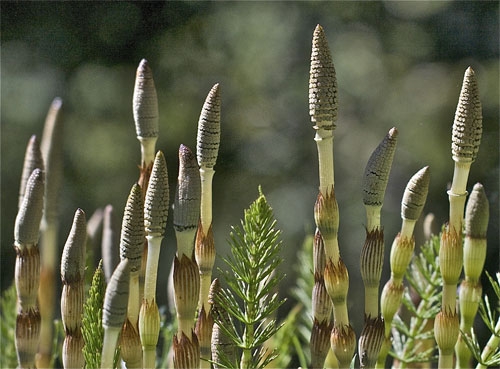Horsetail
Equisetum spp.
Energies and flavors: Cool, astringent
Uses: Hemostatic, astringent, vulnerary
With the advent of Spring comes horsetail, a type of shave-grass that grows in watery places. I’ve been studying several stands of these interesting plants for a few weeks now, watching them pop through the earth, shoot upward and sprout into feathery and bottlebrush-like ‘leaves.’ My walks take me past a stream where they love to flourish, offering me some interesting photo ops.
Horsetail’s fresh, barren stems have long been used medicinally. Older herbalists used it for consumption, dropsy and dysentery. Horsetail decoction has also been used as a vulnerary, stopping bleeding, healing wounds and reducing eyelid swelling when applied externally. High in silica, they are often included in mineral-rich formulas or herbal combinations for strengthening bones.
Horsetail’s main use, however, is as a diuretic to increase the flow of urine. Thus, is used for such urinary issues such as bladder, prostate, urethra and kidney infections. As well, it is used for frequent urination, which may seem contradictory. However, by increasing the flow of urine it empties the bladder so one doesn’t need to urinate as much.
Horsetail is also used as a lithotropic, helping to dissolve kidney and bladder stones. As an astringent, it can stop bleeding, internally and externally, and has particularly been used this way for nosebleeds. When calcined to ash, it supposedly helps alleviate acid indigestion.
When taken regularly, however, horsetail may irritate the kidneys and cause some toxic reactions. Thus treatment should last no more than six days. Another precaution to keep in mind is that a strong decoction of horsetail acts as an emmenogogue, which contraindicates it for pregnancy.

